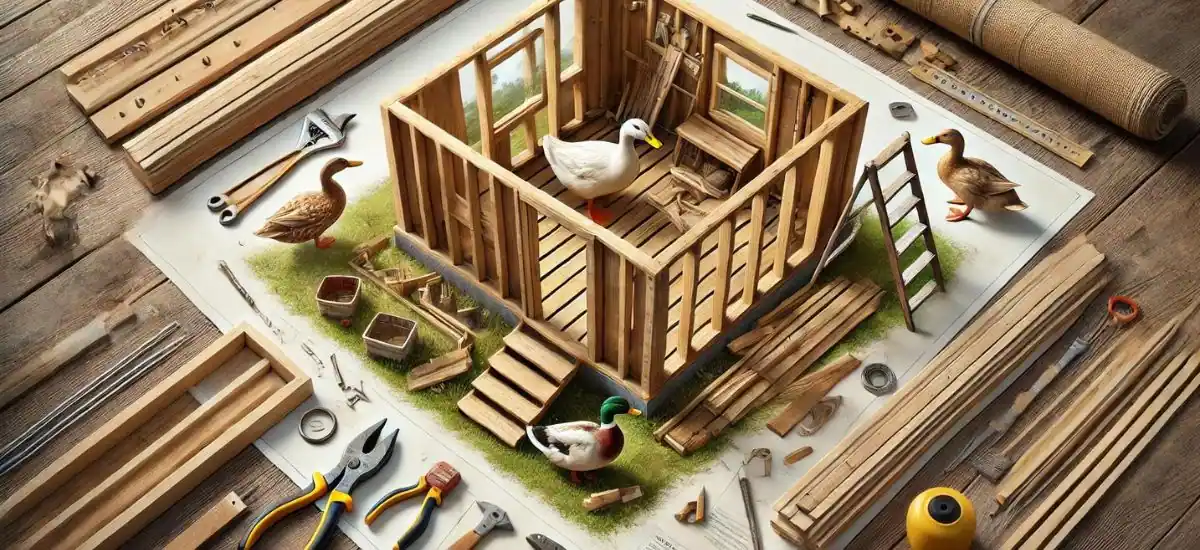Building a duck coop isn’t just about providing shelter; it’s about creating a safe haven where your ducks can thrive. A well-designed coop ensures that your feathered friends are protected, comfortable, and healthy. Plus, there’s undeniable satisfaction in constructing a bespoke habitat for your ducks. This guide will walk you through every step of the process, ensuring that your coop meets all your ducks’ needs while also giving you a sense of accomplishment in a job well done.
Assessing Your Needs
Before diving into construction, take a moment to evaluate what your ducks require for a happy, healthy life. Consider the number of ducks you plan to house, as each duck needs about 4-6 square feet of space inside the coop, with more space in the run or yard. Think about the climate in your area—will you need insulation to protect against cold winters? How about ventilation for hot summers? Assessing these factors beforehand ensures you’re not just building a coop but creating a tailored environment suited for your ducks’ specific needs.
Choosing the Right Location

The location of your duck coop can significantly impact the health and happiness of your ducks. Choose a spot with good drainage to avoid puddles around the coop, as ducks are susceptible to foot problems in muddy conditions. Ensure the area is well-protected from predators by considering visibility from your house and accessibility for maintenance. Additionally, your coop should get sufficient natural light but not direct sunlight throughout the day, which can overheat the interior. A good balance of shade and sun will keep your ducks comfortable year-round.
Materials and Tools Needed
Before you start building, gather all necessary materials and tools. For a standard duck coop, you’ll need:
- Wood: Treated lumber for the frame and exterior panels.
- Nails and Screws: Various sizes for securing different parts.
- Roofing Material: Weather-resistant options like shingles or metal sheets.
- Insulation: Especially important in colder climates to keep ducks warm.
- Wire Mesh: To secure windows and ventilation areas from predators.
- Tools: Hammer, saw, drill, measuring tape, and a level.
Consider your budget and the durability of materials. While it might be tempting to go for cheaper options, remember that investing in quality materials can save you from frequent repairs in the long run.
Designing Your Duck Coop
Designing your duck coop effectively is crucial for ensuring the health and comfort of your ducks. Here are some design tips to keep in mind:
- Space: Plan for at least 4-6 square feet of coop space per duck.
- Accessibility: Include doors or openings that are big enough for cleaning and retrieving ducks if necessary.
- Ventilation: Good airflow is vital to prevent moisture build-up and keep the air fresh.
- Cleaning: Make sure the floor is slightly sloped towards the door to facilitate washing out the coop.
- Nesting Boxes: Provide a few secluded areas for laying eggs.
These design elements not only make the coop functional but also ensure that it is easy to maintain and comfortable for the ducks to live in.
Step-by-Step Building Instructions

Foundation and Frame
- Foundation: Start by laying a strong foundation using concrete blocks or a wooden frame filled with gravel for drainage.
- Frame: Construct the frame using treated wood to outline the coop’s walls, roof, and floor.
Walls and Insulation
- Walls: Erect the walls, attaching the wood panels to the frame with nails or screws.
- Insulation: Fit insulation between the wall panels to keep the coop warm in winter and cool in summer.
Roofing and Protection
- Roofing: Install the roofing material, ensuring it overlaps to prevent water ingress.
- Protection: Secure wire mesh over windows and ventilation holes to keep out predators.
Interior Features
- Nesting Boxes: Build or install nesting boxes in quiet corners of the coop.
- Water Stations: Set up water stations that are easy to clean and refill.
Finishing Touches
- Paint: Apply a coat of non-toxic paint to protect the wood and brighten up the coop.
- Decoration: Add personal touches like decorative trim or weather vanes.
This comprehensive guide provides detailed steps for building a robust and cozy home for your ducks, ensuring they are safe, comfortable, and healthy.
Adding Safety Features
Ensuring the safety of your ducks is paramount when designing and building their coop. Consider the following features to protect them from predators and other dangers:
- Secure Latches: Install robust latches that cannot be easily manipulated by raccoons and other clever predators.
- Fencing: Surround the coop and duck run with sturdy fencing buried at least 12 inches into the ground to deter digging predators.
- Surveillance: Consider setting up a camera or other surveillance methods to monitor any unusual activity around the coop.
- Natural Deterrents: Planting strong-smelling herbs like mint or lavender around the coop can help repel pests naturally.
Incorporating these safety measures will give you peace of mind and keep your ducks secure from potential threats.
Maintenance Tips
Regular maintenance is crucial to ensure the longevity of your duck coop and the health of your ducks:
- Routine Cleaning: Schedule regular cleaning to prevent disease and keep the coop hygienic.
- Inspect for Wear and Tear: Regularly check the coop for any signs of damage or wear, especially after extreme weather conditions.
- Seasonal Adjustments: Make necessary adjustments to the coop to accommodate changing weather, such as adding extra insulation during winter or increasing ventilation during summer.
By adhering to a consistent maintenance schedule, you can extend the life of your duck coop and provide a consistently clean and safe environment for your ducks.
Common Mistakes to Avoid
Building a duck coop can be a rewarding project, but common pitfalls can hinder your progress and the functionality of the coop:
- Underestimating Size Needs: Ensure the coop is spacious enough for all your ducks to live comfortably.
- Poor Ventilation: Avoid designing a coop with inadequate ventilation, which can lead to moisture buildup and respiratory issues in ducks.
- Neglecting Predator Protection: Do not skimp on protective features like secure latches and predator-proof fencing.
Frequently Asked Questions
Q1. What is the best flooring material for a duck coop?
Ans: Consider using straw, sand, or wood shavings as they are easy to clean and replace. Each material has its benefits, such as moisture absorption and odor control.
Q2. How often should I clean the duck coop?
Ans: Aim to do a thorough cleaning at least once a week, with more frequent spot cleanings as needed to maintain a hygienic environment.
Q3. Can I use an old shed as a duck coop?
Ans: Absolutely! Repurposing an old shed can be a great way to provide a spacious home for your ducks. Just make sure to modify it with proper ventilation, secure doors, and predator protection.
Q4. What should I do if my duck coop starts to smell?
Ans: Regular cleaning is key to preventing odors. Additionally, ensure adequate ventilation and consider adding more absorbent bedding materials.
Q5. How do I keep the duck coop warm in winter?
Ans: Insulation is crucial. Ensure the walls and roof are well-insulated, and consider adding a heat lamp for particularly cold nights, ensuring it is safely installed to avoid any fire hazards.
Conclusion
Congratulations on taking the steps to build a duck coop that will serve as a comfortable and secure home for your ducks. By following this guide, you’ve not only created a practical shelter but also contributed to the well-being and happiness of your feathered friends. Remember, the effort you put into building and maintaining the coop directly affects the quality of life for your ducks, ensuring they are healthy, safe, and content. So, pat yourself on the back for a job well done and enjoy the rewarding experience of duck keeping!





